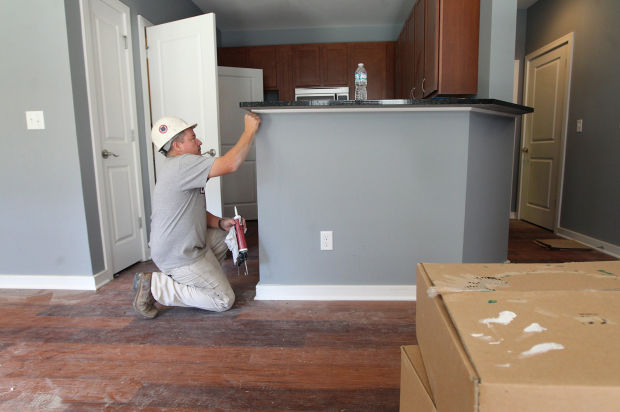(BPT) - Have you been putting off some seemingly hard-to-handle home improvement projects? If so, there’s still time to tackle do-it-yourself tasks like a pro – from painting high ceilings and stairwells to repairing garage and basement floors. With the right tips and tools, you can accomplish these home improvements in a snap.
Reach new heights
When it comes to sprucing up foyers and great rooms, painting may appear to be a challenge for most homeowners – especially when it comes to the ceiling. But it doesn’t have to be. Start by covering furniture and floors with drop cloths or plastic sheeting, or removing furniture from the room entirely.
Start the painting process from the top. A fresh coat of paint on a ceiling can transform a room. Grab a ladder and be mindful of necessary safety precautions. Before painting, shield your eyes by wearing protective goggles. Lightly sand your ceiling and remove any dust with a damp rag or sponge. Then, edge around your ceiling with a paint brush to line the perimeter of the ceiling.
Looking for an easier way to paint the main portion of the ceiling? Select a lightweight and durable extension pole such as the new Purdy Power Lock extension pole, which eliminates pole-to-frame wobbling. The Power Lock pole features a universal tip that connects to nearly all roller frames and rollers, including Purdy Marathon rollers.
Start painting in one corner of the ceiling and form a “V,” then roll the paint out and around. Work in 4-foot sections and always roll into the wet edge of the section you were previously painting. Wait for the ceiling to dry completely and apply another coat.
Safely painting stairwells
Many two-story foyers are accompanied by stairwells with equally tall walls. These high-traffic areas are very visible, yet may be the last place homeowners care to spend time updating. While most areas of the home can be painted with a roller or brush and a basic stepstool, stairwells may pose a safety risk. There are few ways to carefully cross this potentially tricky task off of your to-do list.
A sturdy extension pole that allows for smooth length adjustments is a must. Power Lock extension poles enable the user to safely and effectively paint areas in and out of reach. You can also utilize an extension ladder on the side walls of a stairwell with a ladder leveler. Simply place one leg of the ladder on one step and the other leg, with the ladder leveler attached, on the step below it. Adjust the ladder leveler so that your ladder is resting evenly, and you’re ready to update the walls and ceiling in this space.
If you find yourself in a spot where the results are less than ideal or the job is simply too complex, don’t be afraid to reach out to a professional for assistance.
Repainting basement and garage floors
Has repairing and/or repainting the floor of your garage or basement made your to-do list for years but never seems to be your No. 1 priority? Make this year the one where this project gets done. First, pick up protective eyewear and gloves for the job as it will involve paints and cleaners, and be sure the area is well ventilated. Before beginning, it is best to remove stains by using a three-parts water to one-part bleach mixture. For tougher stains, consider using a pressure washer. Be sure to thoroughly rinse the area. Once the floor is clean and dry, repair any cracks in the concrete using concrete/mortar-repair compound for smaller cracks or concrete patch for larger ones.
Next, you will want to apply a thin primer coat using a paint roller attached to an extension pole like the Purdy Power Lock to ensure you don’t paint yourself into a corner. After eight hours, start with a coat of the floor paint and allow the first coat to dry for one full day before applying the second. Wait about 24 hours before walking or driving on the newly painted surface.
By following these helpful tips and using the proper tools, you can complete lingering projects in no time. You'll then be able to enjoy great looking, long-lasting results.
To order your copy of Remodeling Hell, CLICK HERE
For more information about Remodeling Hell, CLICK HERE
For more information about the Summit Murder Mystery series, CLICK HERE
Follow me on TWITTER
Friend me on FACEBOOK
Follow me on PINTEREST












 and a remodeler. “Doing your due diligence is the best way to not only
protect yourself, but ensure a positive remodeling experience.”
and a remodeler. “Doing your due diligence is the best way to not only
protect yourself, but ensure a positive remodeling experience.”

